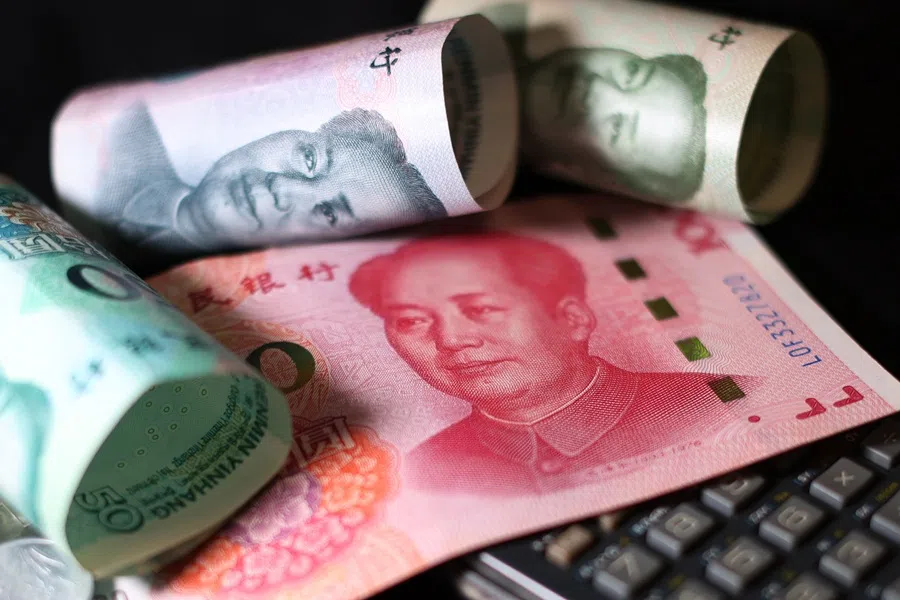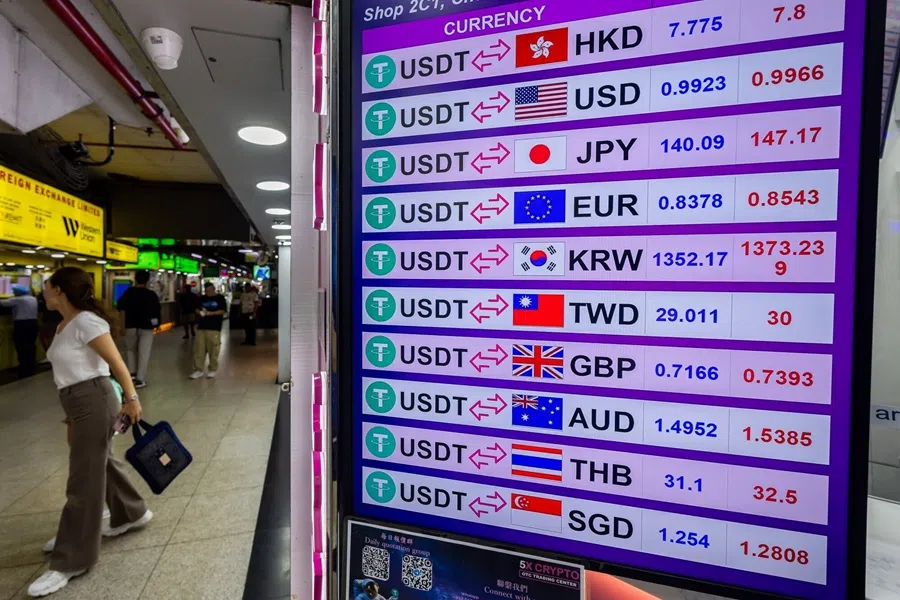Trump’s stablecoin embrace ups pressure on China to join race
As more countries and jurisdictions, including the European Union, Singapore and South Korea embrace stablecoins, these digital tokens, typically issued by private companies, not the state, are likely to play an increasingly significant and potentially pivotal role in international and domestic financial systems. Will China join the global stablecoin race?

(By Caixin journalists Liu Ran, Wang Xiaoqing and Qing Na)
Calls are growing for China to join the global stablecoin race as the US becomes the latest major economy to establish a regulatory framework for the digital asset that could further cement the dollar’s dominance and thwart Beijing’s efforts to boost the RMB’s international status.
The embrace of stablecoins by the US and other jurisdictions, including the European Union, Singapore and South Korea, means these digital tokens, which are typically issued by private companies, not the state, are likely to play an increasingly significant and potentially pivotal role in international and domestic financial systems. They could transform the global cross-border payments landscape as individuals, companies and financial institutions take advantage of their lightning-fast transaction speed and lower costs than the traditional banking system.
The Chinese mainland has so far stayed on the sidelines, maintaining its long-held negative view of cryptocurrencies...
E-commerce giant JD.com Inc. is one of several Chinese companies developing its own stablecoins, a type of cryptocurrency generally based on blockchain technology whose value is pegged to a real-world reserve asset, usually fiat currency such as the US dollar. Its subsidiary, Jingdong Coinlink Technology Hong Kong Ltd., and two subsidiaries of fintech powerhouse Ant Group Co. Ltd. plan to apply for licences to issue stablecoins in Hong Kong, which has been at the forefront of regulating and promoting digital assets.
The digital tokens will “extend the US dollar’s reach into crypto, Web3, and emerging markets with low-cost, near-instant settlement”, Morgan Stanley economists wrote in a 19 June report. “For China, ignoring this trend risks being left behind in the digital infrastructure race — especially as stablecoins increasingly function as bypass mechanisms to traditional banking networks,” they wrote.
China’s reluctance to embrace stablecoins
The Chinese mainland has so far stayed on the sidelines, maintaining its long-held negative view of cryptocurrencies based on concerns they are speculative digital assets that could threaten financial stability, loosen the central bank’s control over the monetary system, and act as a conduit for fraud and money laundering. In 2017, it banned crypto trading platforms and initial coin offerings, and subsequently ordered banks and payment platforms to reject crypto transactions, and shut down Bitcoin mining.

Instead, the authorities have pursued a different route to harness digital money, developing a central bank digital currency (CBDC), known as the e-CNY. As opposed to stablecoins, which are typically issued by private entities and pegged to fiat currencies, the CBDC is issued and supervised by the People’s Bank of China (PBOC) as legal tender.
This allows the central bank to keep control over the financial system and monetary policy implementation, while at the same time allowing users to make almost instant peer-to-peer transactions through digital wallets.
The CBDC has already been rolled out domestically and is now being used to boost RMB internationalisation and grow the currency’s influence in international trade and finance, especially in cross-border transactions. The PBOC announced on 18 June that it will set up an international operations centre for the e-CNY in Shanghai to promote its internationalisation and support financial innovation.
... some analysts say China must support the development of RMB-denominated tokens, which would boost demand for the currency because of likely requirements they will need to be pegged to and backed 1:1 by RMB-denominated assets.
A shift in mindset?
But with stablecoins set to transform the way money is transmitted across borders and given the potential for the US and the dollar to dominate the market, some analysts say China must support the development of RMB-denominated tokens, which would boost demand for the currency because of likely requirements they will need to be pegged to and backed 1:1 by RMB-denominated assets.
Dollar assets, notably US government debt, are already the most-used as reserve backing for stablecoins. As of 8 July, the total stablecoin market cap was around US$260 billion, according to crypto data tracker CoinMarketCap. A recent report from the Bank for International Settlements said that more than 99% of the cryptocurrency is denominated in the dollar, a percentage that far exceeds the dollar’s 48% share of global payments in May.
The majority of US dollar stablecoins are backed by T-bills, short-term US Treasury securities and issuers’ demand for the bills is forecast to surge in the next four years, according to an April report by Standard Chartered Bank.
Nearly 70% and 90% of such cryptocurrencies provided by the world’s two largest stablecoin issuers, Tether Ltd. and Circle Internet Group Inc., respectively, are backed by T-bills, the report noted.

Estimates from investment banks underscore the impact that growth in the stablecoin market could have on perpetuating the dollar’s dominance. Standard Chartered Bank estimated the supply of stablecoin will rise to US$2 trillion by 2028 — an around ninefold increase on the current supply.
The growth will generate some US$1.6 trillion of new demand for T-bills, enough to absorb all new T-bill issuance planned for the rest of President Donald Trump’s current term, its analysts said. “As stablecoin usage increases, this additional source of USD demand should support USD hegemony, acting as a medium-term offset against the current threat to USD hegemony on the back of tariff concerns,” they wrote.
The PBOC hasn’t made any major public statement about its position on stablecoins, but governor Pan Gongsheng has acknowledged them as one of the emerging technologies that are transforming cross-border payments, bringing both efficiency gains and regulatory challenges.
Pan’s reference to stablecoins... has fuelled speculation that authorities may be shifting their approach out of concern that the fast-growing market will be dominated by the US and the dollar.
“Underpinned by new technologies such as blockchain and distributed ledgers, central bank digital currencies and stablecoins are thriving, making possible the simultaneous processing of payment and settlement,” Pan said in a speech at the Lujiazui Forum on 18 June. “The development has fundamentally reshaped the traditional payment landscape and significantly shortened the cross-border payment chain. However, it has also posed great challenges to financial regulation,” he said, without elaborating on those challenges.
Pan’s reference to stablecoins, along with calls from academics and advisers for China to support RMB-backed tokens, has fuelled speculation that authorities may be shifting their approach out of concern that the fast-growing market will be dominated by the US and the dollar. The issue has gained added urgency following the Senate’s passage of the GENIUS Act (Guiding and Establishing National Innovation for US Stablecoins Act of 2025) in June, which is expected to become law by August.
The law would establish a federal-level regulatory framework for payment stablecoins, moving them out of a fragmented regulatory landscape and putting them under official oversight.

Only permitted issuers would be allowed to issue stablecoins, and they would have to be backed at least 1:1 with highly liquid US dollar assets, including cash and Treasury securities maturing within 93 days.
Digital dollar curbs
Some government advisers and experts say Chinese regulators can no longer afford to stand on the sidelines given the potential for stablecoins to transform cross-border payments and disrupt traditional financial systems.
“It must be recognised that the trend of integration between stablecoins, cryptocurrencies and the traditional financial system will be difficult to reverse,” said Li Yang, a member of the Chinese Academy of Social Sciences, a top government think tank. “Although in previous years, some countries supported only CBDC experiments, while others focused on fostering innovation in stablecoins and cryptocurrencies, most have recently shifted toward a model that supports the coordinated development of all three,” he said in a speech to an investor summit in Shanghai last month.
Hong Kong has been laying the groundwork to become an international centre for virtual assets (VAs) such as cryptocurrencies since 2022, as it seeks to bolster its status as a global financial hub and ward off competition from Singapore.
How China can embrace stablecoins is the big question, given the ban on cryptocurrency trading activities on the mainland. Some experts, including Li and Xiao Feng, chairman of Wanxiang Blockchain Labs, a research institution focused on blockchain technology, say China should leverage Hong Kong’s status as an international financial hub to develop offshore RMB stablecoins. This pathway could also provide a framework for an onshore stablecoin when conditions are ripe.
Hong Kong has been laying the groundwork to become an international centre for virtual assets (VAs) such as cryptocurrencies since 2022, as it seeks to bolster its status as a global financial hub and ward off competition from Singapore. In 2023, it set up a mandatory licensing regime for VA trading platforms and last year allowed crypto-linked exchange-traded funds invested in spot Bitcoin and Ether to begin trading.
In May this year, the city’s legislature passed the Stablecoins Bill, which will go into effect as an ordinance on 1 August and set out a comprehensive regulatory regime for the digital asset. It will include mandatory licensing for issuers, rigorous standards comparable with those imposed on banks, and a requirement that stablecoins be backed by reserve assets on at least a 1:1 basis. The law will allow licensed companies to issue stablecoins pegged to various currencies, not just the Hong Kong dollar.

Tether — the private company that issues the world’s most widely used stablecoin, known by its ticker symbol, USDT — launched a stablecoin pegged to the offshore RMB, CNHT, as far back as 2019, although it has seen limited adoption and is mainly used for crypto trading.
“We should make full use of Hong Kong’s favourable conditions, leveraging its status as a financial hub with existing institutional resources to develop an offshore RMB-pegged stablecoin and establish a controllable international payment channel,” Li said in his speech. In other words, China should create an RMB-linked stablecoin issued and circulated outside the mainland, he said.
Hong Kong’s Stablecoins Ordinance has fuelled aspirations for offshore RMB stablecoins. While so far China hasn’t made any public pronouncement on its stance, experts believe PBOC approval would be necessary, just as US or Hong Kong regulatory approval is required, respectively, for offshore dollar or Hong Kong dollar stablecoins.
Wang Yongli, a former executive vice-president of Bank of China Ltd., is among high-profile figures in the financial world who are advocating for RMB stablecoins to counter the dominance of dollar stablecoins and seize control of digital trade settlement.
Duncan Chiu, a member of the Hong Kong Legislative Council, said that discussions about the feasibility of RMB stablecoins took place during the drafting of the ordinance. Given Hong Kong’s liquidity pool of roughly 1 trillion offshore RMB, collateralising offshore RMB assets to issue stablecoins is considered viable, according to Chiu.
Companies including Jingdong Coinlink have said they plan to issue Hong Kong dollar and US dollar stablecoins, and to add other currencies depending on market demand and regulatory requirements. Meanwhile, Circle, a US-based payment technology platform that issues USDC, the second-biggest US dollar-backed stablecoin, has also expressed interest in expanding to Hong Kong.

Wang Yongli, a former executive vice-president of Bank of China Ltd., is among high-profile figures in the financial world who are advocating for RMB stablecoins to counter the dominance of dollar stablecoins and seize control of digital trade settlement.
Zou Chuanwei, director of the Frontier Finance Research Center at the Shanghai Institution for Finance and Development, says offshore RMB stablecoins are preferable to onshore ones, given the mainland’s tight capital controls and highly developed mobile payment ecosystem dominated by WeChat Pay and Alipay.
Zou suggested that the reserve assets backing offshore RMB stablecoins could be custodied with offshore RMB clearing banks and managed by overseas branches of mainland financial institutions. China could then use internet IP blocking and other technical measures to prevent onshore access to offshore digital wallets and crypto exchanges, effectively managing capital outflows without disrupting onshore financial stability.
Wang Liwei contributed to this story.
This article was first published by Caixin Global as “In Depth: Trump’s Stablecoin Embrace Ups Pressure on China to Join Race”. Caixin Global is one of the most respected sources for macroeconomic, financial and business news and information about China.




![[Big read] China’s 10 trillion RMB debt clean-up falls short](https://cassette.sphdigital.com.sg/image/thinkchina/d08cfc72b13782693c25f2fcbf886fa7673723efca260881e7086211b082e66c)
![[Big read] Love is hard to find for millions of rural Chinese men](https://cassette.sphdigital.com.sg/image/thinkchina/16fb62fbcf055b710e38d7679f82264ad682ce8b45542008afeb14d369a94399)